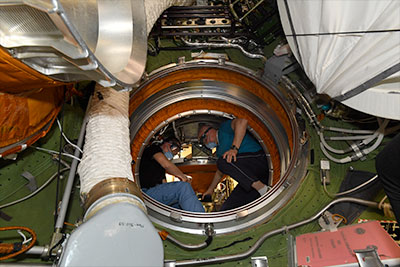When the module was pulled by the hooks of the docking station, I realized that they would not let it go anywhere and, frankly, invited some colleagues to have tea in my office. I emphasize tea. An hour and a half later we went to the control room, where it turned out that there was a sign of “withdrawal” in the on-board computer of the module, there was no sign of "coupling." This means that the "brains" of the machine believe that it is in autonomous flight: "How is it, I am still flying, and you have already tied me up." A paradoxical situation arose when our module, despite the fact that it was docked, was pulled together by hooks, each withstands eight tons per rupture, but nevertheless an autonomous flight program operates in the module's software. As a result, the computer issued the command "withdraw" and the engines worked for seven seconds.
Isn't it seven seconds, isn't it 45 minutes?
This is the first time. The second time they worked as they should (laughs).
After the first inclusion, we thought, because the situation was completely incomprehensible to us, from the realm of fantasy. But the problem was not only turning on the engines. During the flight to the ISS, the Nauka solar batteries generated four times more energy than the module required to maintain the systems in operation - 200 amperes/hour at a flow rate of 50 amperes/hour. But after the first switching on of the Nauka engines, six orbits (nine hours - ed.) Were waiting for us in the shadow zone. And the module was not connected to the ISS unified electrical system.
For the shadow section, all the systems of the module would be de-energized, and we would not be able to control it. Therefore, we needed to switch to common power supply from the ISS, so that the module and the station were connected in terms of energy.
I had to act in time trouble. Everything was complicated by the fact that there was an old control system in the module, which already worked with difficulty on the first day ... I was an active astronaut when such machines were used. The oldest blocks of the Nauka control system were manufactured in Soviet Union in 1986-1990.
There was not much time left before entering the shadow, and there were few control sessions through the ground measuring points, there was no time left for ground training of commands, so we had to immediately send commands on board. The main task was to combine the power systems of the module and the ISS. And in the last communication zone, during the last session, we managed to bypass the no-coupled mode.
It was dashing: to scratch your left ear with your right hand - to electrically combine the module with the station, although Nauka understood that it was mechanically disconnected.
At night they have already begun to figure out how to correct the "brains" of "Nauka" so that it understands that it is in a coupled state. Now we do not know grief, all our computers are united, for communication we use a satellite control loop.
That is, the problem was not in some sensor, which did not show that there was a docking?
The problem was a complex software that had a bug. It was impossible to catch it in our ground models.
After turning on the Nauka engine and turning the ISS, the American colleagues got scared. How reasonable was their fear? As far as I understand, the greatest danger was for the solar array drives, the teeth of which could be damaged by the load during an unplanned maneuver.
An hour after what happened, I talked with my colleague Joel Montalbano, the ISS program manager at NASA , whom I have known since 1993. I asked him about solar panels. He reassured me that the impact was two times less than the limit. He and his flight control team believe that nothing terrible has happened. Well, it turned around, so what?


















